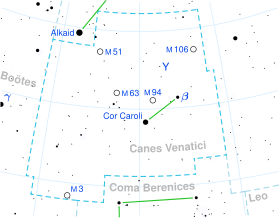Beta Canum Venaticorum
| Observation data Epoch J2000 Equinox J2000 | |
|---|---|
| Constellation | Canes Venatici |
| Right ascension | 12h 33m 44.54425s[1] |
| Declination | +41° 21′ 26.9214″[1] |
| Apparent magnitude (V) | 4.25[2] |
| Characteristics | |
| Spectral type | G0 V[3] |
| U−B color index | 0.04[4] |
| B−V color index | 0.58[4] |
| Absolute magnitude (MV) | 4.64[6] |
| Details | |
Gyr | |
| Database references | |
| SIMBAD | data |
| ARICNS | data |
Beta Canum Venaticorum (β Canum Venaticorum, abbreviated Beta CVn, β CVn), also named Chara .
Along with the brighter star Cor Caroli, the pair form the "southern dog" in this constellation that represents hunting dogs.
Nomenclature
β Canum Venaticorum (Latinised to Beta Canum Venaticorum) is the star's Bayer designation.
The traditional name Chara was originally applied to the "southern dog", but it later became used specifically to refer to Beta Canum Venaticorum. Chara (χαρά) means 'joy' in Greek.[14] In 2016, the International Astronomical Union organized a Working Group on Star Names (WGSN)[15] to catalog and standardize proper names for stars. The WGSN's first bulletin of July 2016[16] included a table of the first two batches of names approved by the WGSN; which included Chara for this star.
In
Observations
Beta CVn has a
Beta CVn is considered to be slightly metal-poor,[9] which means it has a somewhat lower portion of elements heavier than helium when compared to the Sun. In terms of mass, age and evolutionary status, however, this star is very similar to the Sun.[21] As a result, it has been called a solar analog. It is about 3% less massive than the Sun,[2] with a radius 12% larger than the Sun's and 15% greater luminosity.[8]
The components of this star's
Habitability
In 2006, astronomer Margaret Turnbull labeled Beta CVn as the top stellar system candidate to search for extraterrestrial life forms.[24] Because of its solar-type properties, astrobiologists have listed it among the most astrobiologically interesting stars within 10 parsecs of the Sun.[21] However, as of 2009, this star is not known to host planets.[2]
See also
References
- ^ .
- ^ S2CID 18370219.
- doi:10.1086/191373.
- ^ .
- Bibcode:1953GCRV..C......0W.
- ^ S2CID 118577511.
- ^ ISSN 0004-6361.
- ^ S2CID 18993744.. See Table 10.
- ^ doi:10.1086/504080.
- S2CID 119299265.
- ^ "bet CVn -- Spectroscopic binary". SIMBAD. Centre de Données astronomiques de Strasbourg. Retrieved 2010-07-04.
- ISBN 978-1-931559-44-7.
- ^ "IAU Catalog of Star Names". Retrieved 28 July 2016.
- ^ Kaler, Jim. "Beta Canum Venaticorum". Stars. University of Illinois. Archived from the original on 2007-02-20. Retrieved 2006-12-06.
- ^ "IAU Working Group on Star Names (WGSN)". Retrieved 22 May 2016.
- ^ "Bulletin of the IAU Working Group on Star Names, No. 1" (PDF). Retrieved 28 July 2016.
- ISBN 978-986-7332-25-7.
- ^ (in Chinese) 香港太空館 - 研究資源 - 亮星中英對照表 Archived 2009-09-29 at the Wayback Machine, Hong Kong Space Museum. Accessed on line November 23, 2010.
- Bibcode:1993AAS...183.1710G. Archived from the originalon 2019-06-25. Retrieved 2012-02-04.
- doi:10.1086/162887.
- ^ S2CID 119459291.
- doi:10.1086/165281.
- S2CID 8888863.
- PhysOrg.com. 2006-02-19. Retrieved 2008-05-04.
External links
- "Chara". SolStation. Retrieved 2006-12-06.
- "Astronomer announces shortlist of stellar candidates for habitable worlds". SpaceRef.com. 2006-02-18. Retrieved 2006-08-10.[permanent dead link]

